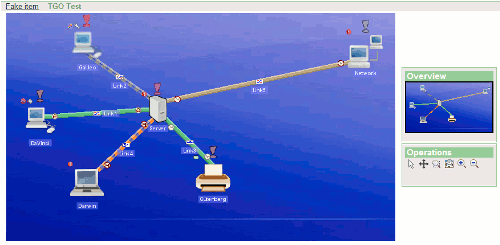Perforce JViews TGO Sample: JViews TGO Faces component in a Facelets and Trinidad Context
Description
 |
This sample shows how to use the JViews JavaServer Faces components in a Facelets or Trinidad context.
Installing the Thin-Client Sample
The sample contains a WAR file (Web Archive) that allows you to easily install the sample on any server that supports the Servlet API 2.1 or later. For your convenience, the WAR will be copied to the Tomcat web server that is supplied with the Perforce JViews installation when you start the server using the supplied scripts. Tomcat is the official reference implementation of the Servlet and JSP specifications. If you are already using an up-to-date Web or application server, there is a good chance that it already has everything you need. The sample can also be deployed to WebSphere Application Server (WAS).
Running the Sample Using Tomcat
If you intend to use the Tomcat Web server provided with this
installation, follow these instructions to start the server:
Running the Server-Side Samples.
The scripts to start the server can be found in the
tools/tomcat-facelets directory.
Note: if you are running on Windows then you will find menu items in
the Windows "start" menu to start and stop the Tomcat server.
Once the server is running, you can see the sample by opening the following page:
- Perforce JViews TGO Sample: JViews TGO Faces component in a Facelets and Trinidad Context
http://localhost:9090/jsf-tgo-facelets
Running the Sample Using WebSphere Application Server
In addition to the instructions provided for using Tomcat, the samples can be
viewed on WebSphere Application Server. Follow the instructions:
Running the Server-Side Samples
and use the scripts to start the server and deploy the sample.
Once the server is running, you can see the sample
by opening the following page:
http://localhost:9443/jsf-tgo-facelets
The WAS administrative console can be used to verify or modify server settings:
http://localhost:9043/ibm/console/
Note: the WAS server can start on a range of port numbers, therefore the value
is not guaranteed to remain the same.
The scripts provided with the samples can be used to obtain the port numbers used
by the Admin Console and by the deployed Web applications.
To retrieve a list of all the WAS port numbers, run the command line instruction:
ant -f build_was.xml ws.list.ports
Topics Covered
- JavaServer Faces TGO
- Facelets
- Apache Trinidad
Detailed Description
This sample groups several code fragments. Each code fragment is an XHTML Facelets page.
The sample also includes several XML configuration files that enable you to use JViews components in a Facelets and Trinidad context.
Installation Directory
The JViews TGO Faces component in a Facelets and Trinidad Context sample is installed here.
Classes Involved
Source Files
-
SampleContext
The context object that provides the network model.
-
AbstractSampleContext
Base context object used to maintain references to objects.
-
action.AlarmStateHandler
Handles the alarm management.
-
popup.PopupMenuFactory
Defines a pop-up menu factory for the network view.
-
renderer.NEBaseRendererFactory
Base renderer factory for the custom network element types.
-
tgo
This page shows how to display JViews TGO JSF Components in a Facelets context.
-
tgo-trinidad
This page shows how to display JViews TGO JSF Components in a Facelets and Trinidad context.
-
WEB-INF/faces-config
This configuration file shows how to set up Trinidad and Facelets rendering for JSF.
-
WEB-INF/faces-config-std
This configuration file shows how to set up Facelets rendering for JSF.
-
WEB-INF/web-std
This configuration file shows how to set up a Facelets application for Perforce JViews.